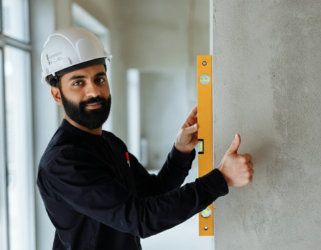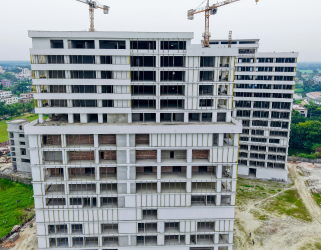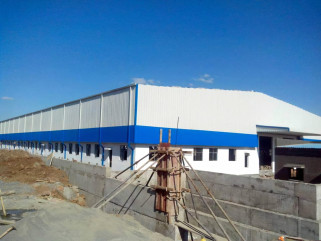Comparing PEB, Hybrid, and Traditional Construction: Which Is Best for Your Project?

When beginning a construction project, deciding on the best construction method is one of the most critical choices you’ll face. Whether you’re building a factory, a warehouse, or even an office space, the method you choose heavily impacts everything from timelines to budgets and sustainability. However, with so many options to choose from—including Pre-Engineered Buildings (PEBs), hybrid construction, and traditional methods like Reinforced Cement Concrete (RCC)—how do you figure out which is the right fit for your project?
To help you make an informed decision, we’ll break down the differences through a practical lens, spotlighting the pros and cons of PEB vs traditional construction, hybrid construction vs conventional methods, and everything in between. Plus, we'll share examples to make these comparisons tangible and useful for anyone in the construction industry.
Understanding Pre-Engineered Buildings (PEBs)
Imagine this. You’re tasked with constructing an industrial warehouse on a tight deadline. It needs to be both cost-effective and durable, with room for future expansion. Enter pre-engineered buildings (PEBs). PEBs are composed of steel frames and are fabricated off-site in specialized factories. Every component is predesigned for efficient assembly, leading to faster construction times and reduced costs.
Pros of PEBs:
- Speed: Because components are pre-fabricated, PEBs can be assembled in a fraction of the time required for traditional methods.
- Cost-Effectiveness: Because steel is pre-engineered, there's minimal waste or overages, keeping costs manageable.
- Customizability: PEBs offer immense flexibility in design, whether you need high ceilings, column-free spaces, or bespoke layouts.
- Sustainability: Using steel (a recyclable material) and reducing on-site waste make PEBs an eco-friendly choice.
One of Metrosh’s recent clients needed a logistics center up and running in just three months. By choosing PEB, not only did they meet the deadline, but they also saved 20% compared to RCC costs.
Cons of :
- Initial Design Dependencies: Customization must be finalized early since changes mid-production are more challenging.
- Specialized Assembly: PEB installation requires skilled labor and equipment specific to steel construction.
Traditional RCC Construction Explained
Reinforced Cement Concrete (RCC) construction has long been the go-to method in the industry, especially for structures requiring exceptional durability, like housing complexes and multi-floor office buildings. Unlike PEBs, RCC relies heavily on on-site work, including reinforcement through steel bars and layers of cement.
Pros of RCC:
- Robust Durability: RCC structures can stand up to fire, earthquakes, and harsh environmental conditions.
- Familiarity: Most construction crews are trained in conventional RCC processes, requiring no special tools.
However, traditional construction methods can be slow-moving, as materials need to be sourced and mixed on-site. A manufacturing facility building in Gujarat reportedly took nearly two years to complete using RCC due to its labor-intensive processes.
Cons of RCC:
- Time-Intensive: Large reliance on on-site work extends construction timelines significantly.
- Higher Material Costs: Materials like cement and rebar can drive project costs higher than expected.
- Limited Sustainability: RCC generates more waste and carbon emissions compared to steel-based PEBs.
Where Hybrid Construction Fits
Hybrid construction, as the name suggests, blends the best elements of PEB and RCC. For example, you might combine RCC for foundations or specific sections needing extra durability with pre-engineered steel framing for faster assembly and cost savings.
A recent example is a college campus project that used an RCC base for its dormitories and integrated PEB for its gymnasium and sports complex. This hybrid method achieved strength where necessary and accelerated construction on non-critical areas.
Pros of Hybrid Construction:
- Flexibility: Combines PEB’s speed with RCC’s durability.
- Specialized Application: Allows you to tailor the construction method to specific parts of a project.
Cons of Hybrid Construction:
- Coordination Challenges: Managing two methodologies may complicate project logistics.
- Cost Variance: Hybrid methods don’t always guarantee cost efficiency as material sourcing and dual skilled labor are needed.
Comparing PEB, Hybrid, and RCC
1. Speed:
When you’re working on a tight timeline, PEB clearly outshines both RCC and hybrid methods. While PEB reduces assembly time to weeks, RCC can take months or even years. Hybrid construction falls somewhere in between, depending on the project scope.
2. Cost:
PEB emerges as a highly cost-effective solution. It eliminates onsite material overages and reduces labor requirements. RCC is usually the most expensive due to its reliance on concrete and man-hours, while hybrid construction is more cost-competitive but requires precise budgeting.
3. Sustainability:
PEBs are a standout in the PEB vs RCC building comparison here. Steel is not only recyclable but also requires less energy to assemble compared to mixing concrete on-site, which releases significant amounts of CO2. Hybrid projects can incorporate sustainable practices but rarely match PEB’s efficiency.
4. Customization:
PEBs offer unparalleled customization options, allowing you to maximize space utilization. RCC is less flexible by comparison, constrained by its rigid and labor-intensive processes. Hybrid construction, although customizable, relies heavily on finding the correct balance of both methods.
Best Construction Method for Industrial Projects
For industrial projects like warehouses, manufacturing units, and logistics centers, PEBs are often the best choice. They balance cost, speed, and sustainability, all of which are critical in today’s competitive market. However, for high-rise or load-intensive structures, hybrid or RCC methods might be more practical options.
Choosing the Right Path with Metrosh
When it comes to balancing speed, cost, and sustainability, Metrosh is a trusted leader in PEB construction. From designing custom solutions that meet unique project requirements to delivering eco-friendly, space-efficient steel structures, Metrosh raises the bar in pre-engineered steel building construction. Every PEB crafted by Metrosh is built with 100% customization, optimizing your space while ensuring exceptional strength and safety.
Whether you’re comparing PEB and RCC for a new project or weighing hybrid construction vs conventional methods, Metrosh is your partner in finding the perfect solution. With a proven commitment to quality and sustainability, Metrosh doesn’t just build structures; it builds confidence. Let's redefine what your construction project can achieve!
Our Services
Pre-Engineered Buildings | Civil Construction | Hybrid Constructions
FAQs
1. What is the difference between PEB, hybrid, and traditional construction methods?
PEB involves pre-fabricated steel components assembled on-site, enabling speed and cost efficiency. Hybrid construction combines PEB and RCC, leveraging the strengths of both. Traditional methods like RCC rely on labor-intensive, on-site construction, ideal for high-load or multi-storey designs but slower and less sustainable.
2. Which construction method is most cost-effective for commercial projects?
PEB is the most cost-effective due to reduced material wastage, faster assembly, and minimal labor requirements compared to hybrid or traditional construction.
3. What are the structural and design limitations of each method?
- PEB: Best for simple to moderately complex designs but limited in extreme architectural detailing.
- Hybrid: More adaptable but complex to coordinate and costlier.
- RCC: Highly durable but less efficient for large spans or customizable layouts.
4. Is PEB suitable for multi-storey or complex architectural designs?
Yes, PEB can handle low to medium-rise multi-storey buildings and fairly complex designs, but highly intricate structures often require hybrid or traditional methods.
5. Which construction type offers the most sustainable and eco-friendly benefits?
PEB leads in sustainability, using recyclable steel and energy-efficient manufacturing processes, producing less waste compared to hybrid or traditional RCC methods.
Related Articles

Why Pre-Engineered Buildings Are the Ultimate Cost-Saving Solution?
24 Sep 2025
Strong, Durable, and Long-Lasting: The Structural Superiority of PEBs
23 Sep 2025
Quality Control in Civil Construction: Metrosh Infra’s Standards and Practices
22 Sep 2025
Cost-Efficiency in Hybrid Construction: Balancing Budget and Quality
22 Sep 2025
Building the Future: Metrosh Infra’s Approach to Turnkey Civil Construction
20 Sep 2025


